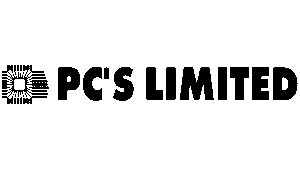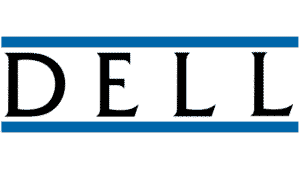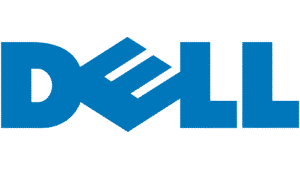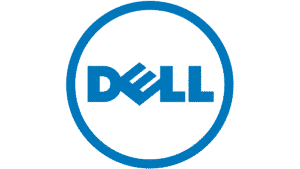
Dell Technologies is a US-based technology company that manufactures computers, peripherals, networking equipment, data storage devices, laptops, servers, televisions, and MP3 players. The Dell Technologies logo is one of the most recognisable emblems in the global technology industry. It symbolises innovation, reliability, and a commitment to customer-centric solutions. Its evolution reflects the journey of the company from a small PC startup to a multinational technology leader. The article explores the various logo iterations of Dell Technologies, among other details of the company.
The Genesis of the Dell Technologies Logo (1984 – 1987)
Dell began as PC’s Limited, and its first logo featured a bold, uppercase wordmark in black and written using a narrowed sans-serif typeface. It was accompanied by a geometric square emblem resembling a microcircuit to the left. This design reflected the company’s focus on computers and technology, with the square emblem symbolising safety, security, and stability. The monochrome palette and strong lines conveyed confidence and seriousness, which set the foundation for the visual identity of Dell.

(1987 – 1989)
After rebranding to Dell, the logo was updated to feature the new name in capital letters and framed by two thick horizontal blue lines. The letters of the logotype were large but with small serifs. This introduced the iconic blue colour to represent trust, loyalty, and wisdom, while the parallel lines symbolised eternity and confidence. The design was more elegant and professional, and it aligned with Dell’s growing ambitions in the tech industry.

(1989 – 2018)
Dell’s logo underwent another transformation in 1989 with the introduction of the now-famous tilted “E”. Designed by Siegel and Gale design bureau, the wordmark, rendered in a bold sans-serif typeface and vibrant blue colour, became instantly recognisable. The slanted “E” symbolised the founder’s vision to “turn the world on its ear”. This infused the logo with creativity and a sense of dynamism. This version of the logo remained largely unchanged for over two decades, and it became a hallmark of Dell’s brand identity.

(2010 – 2016)
Dell modernised its logo by encasing the blue wordmark in a circular frame. The circle represented unity, security, and Dell’s global presence. And the wordmark inside written in the Futura Extra Bold font maintained the logo’s sharpness and readability. The design was further refined with thinner lines and increased spacing to enhance clarity and balance.

(2016 – Present)
After the historic merger with EMC, Dell Technologies introduced a refreshed logo. The new design retained the iconic blue, the tilted “E”, and the circular frame. However, it featured a lighter and more modern typeface and a thinner ring to reflect a cleaner and more contemporary look. The logo update was carried out in collaboration with leading branding agencies, including Lippincott. This ensured the logo reflected both Dell’s legacy and its future as a technology solutions provider.

The Elements of the Dell Technologies Logo
Font
The Dell Technologies logo employs a sans-serif typeface. The letter “E” in the logo is tilted to the left, and the top and bottom ends balance themselves on the “D” and “L” letters, respectively.
Colour
The Dell Technologies logo uses blue and white colours, where white forms the background.
The History of Dell Technologies
Dell Technologies was originally founded as PC’s Limited in 1984 by Michael Dell while he was still a freshman in college at the University of Texas at Austin. He began as a direct-sales pioneer in the personal computer industry. The early success of the company was based on selling affordable, customised IBM-compatible PCs directly to customers. It bypassed traditional retail channels and allowed for tailored systems and rapid delivery.
By 1987, PC’s Limited had rebranded as Dell Computer Corporation and quickly established itself as a market innovator. It produced some of the fastest-performing PCs and opened its first international subsidiary in the United Kingdom. In 1988, Dell went public and raised $30 million. This enabled it to go for rapid global expansion, including establishing manufacturing centres in Ireland to serve Europe, the Middle East, and Africa.
Throughout the 1990s, Dell continued to grow. It even appeared on the Fortune 500 in 1992 and expanded operations across Asia, Japan, and the Americas. The launch of Dell.com in 1996 marked a significant milestone. It made Dell one of the first major computer companies to embrace e-commerce, with online sales reaching $1 million a day within six months. By 2001, Dell had become the world’s largest computer systems provider.
In the early 2000s, Dell broadened its product portfolio to include consumer electronics such as televisions, digital cameras, and printers, and in 2003, the company was renamed Dell Inc. to reflect its expanded offerings. However, market challenges and quality issues led to a decline in the mid-2000s. This forced Michael Dell to return as CEO in 2007 and refocus the company on innovation and customer service.
In 2013, Michael Dell and the private equity firm Silver Lake Partners took the company private in a $24.4 billion deal. This was aimed at prioritising long-term investments and innovation. This period saw Dell aggressively expand its enterprise capabilities through acquisitions, including Perot Systems and various software and storage companies.
The defining moment came in 2016, when Dell acquired EMC Corporation for approximately $60 billion, which was the largest technology deal at the time. This led to the creation of Dell Technologies, a powerhouse in IT infrastructure, cloud computing, and data storage. In 2018, Dell Technologies returned to the public markets by bypassing a traditional IPO. It bought back shares that tracked the company’s financial performance.
Today, Dell Technologies is headquartered in Round Rock, Texas, and is recognised as a global leader in computer hardware, software, and IT services, with a continued focus on innovation and customer-centric solutions.
Interesting Facts About Dell Technologies
- Dell Technologies started in 1984 as PC’s Limited. It was founded by a 19-year-old Michael Dell from the dorm room of the University of Texas with just $1,000 in seed money.
- Dell revolutionised the PC industry by selling customised computers directly to customers. It did so by skirting traditional retail channels and offering competitive prices and better customisation.
- The company grew so quickly that its 1988 IPO raised $30 million. And by the end of its first full year of operation, it had generated $73 million in revenue.
- Michael Dell became the youngest CEO ever to lead a Fortune 500 company when Dell made the list in 1992.
- Dell was among the first major computer companies to embrace e-commerce. It launched online sales in 1996 and quickly reached $1 million in daily online sales within six months.
- Dell established manufacturing centres worldwide, including in the US, Ireland, Brazil, and China, to serve global markets.
- Dell Technologies was formed in 2016 through the $60 billion acquisition of EMC Corporation, the largest technology deal at the time.
- Dell’s headquarters in Round Rock, Texas, is powered by gas converted from landfill emissions and wind power. The company is a leader in sustainability and recycling efforts.
- Dell was the first company to offer long-lasting lithium-ion batteries in notebooks in 1994, and it continues to innovate in enterprise solutions, data storage, and cloud services.
- In 2007, Dell shifted from its direct sales model to embrace channel partnerships. It is now working with thousands of partners worldwide.
- Dell’s Secureworks division provides advanced cybersecurity solutions, which help businesses to protect their data and systems.
Finally
The Dell Technologies logo has evolved through five major iterations. Each of the logos reflects the growth, strategic shifts, and commitment to innovation by the company. From its humble beginnings as PC’s Limited to its current status as a global tech powerhouse, the logo remains a powerful symbol of Dell’s mission to make technology accessible, reliable, and transformative for all.